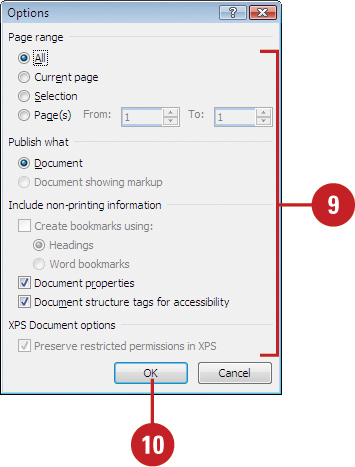XML Paper Specification (XPS)
is a secure fixed-layout format developed by Microsoft that retains the
form you intended on a monitor or printer. An XPS is useful when you
want to create a document primarily intended to be read and printed, not
modified. Office allows you to save a document as an XPS file, which
you can send to others for review in an e-mail. XPS includes support for
digital signatures and is compatible with Windows Rights Management for
additional protection. The XPS format also preserves live links with
documents, making files fully functional. To view an XPS file, you need
to have a viewer—free downloadable software from Microsoft Office
Online—installed on your computer.
Save a Document as an XPS Document
 Click the File tab, click Save & Send, and then click Create PDF/XPS Document. Click the File tab, click Save & Send, and then click Create PDF/XPS Document.
 Click the Create PDF/XPS button. Click the Create PDF/XPS button.
 Click the Save as type list arrow, and then click XPS Document. Click the Save as type list arrow, and then click XPS Document.
 Click the Save in list arrow, and then click the folder where you want to save the file. Click the Save in list arrow, and then click the folder where you want to save the file.
  Type an XPS file name. Type an XPS file name.
 To open the file in viewer after saving, select the Open file after publishing check box. To open the file in viewer after saving, select the Open file after publishing check box.
 Click the Standard or Minimum size option to specify how you want to optimize the file. Click the Standard or Minimum size option to specify how you want to optimize the file.
 Click Options. Click Options.
 Select the publishing options you want, such as what to publish, range
to publish, whether to include non-printing information, or XPS options.
Select the publishing options you want, such as what to publish, range
to publish, whether to include non-printing information, or XPS options.

 Click OK. Click OK.
 Click Publish. Click Publish.
|